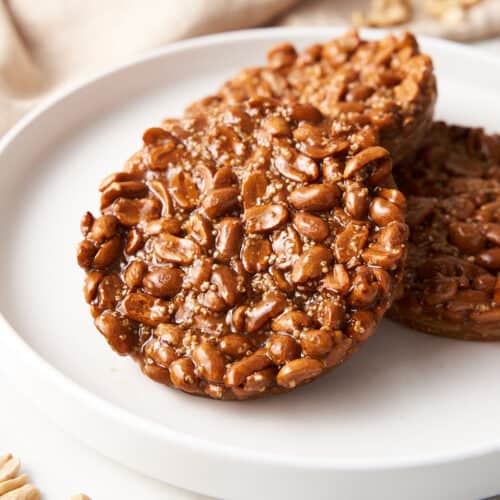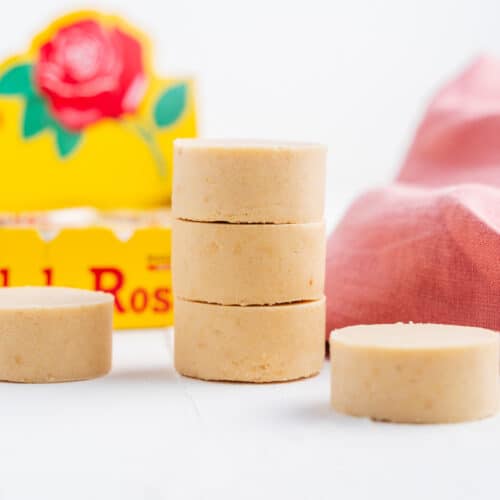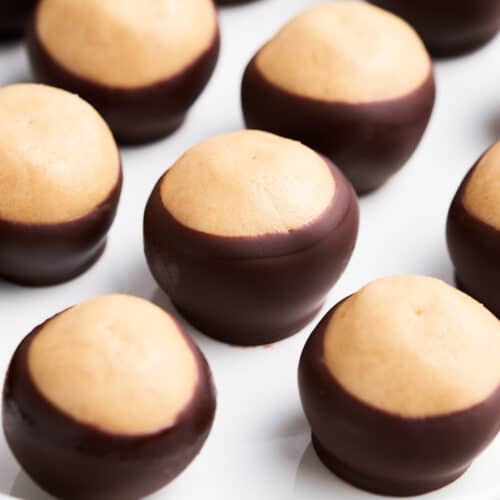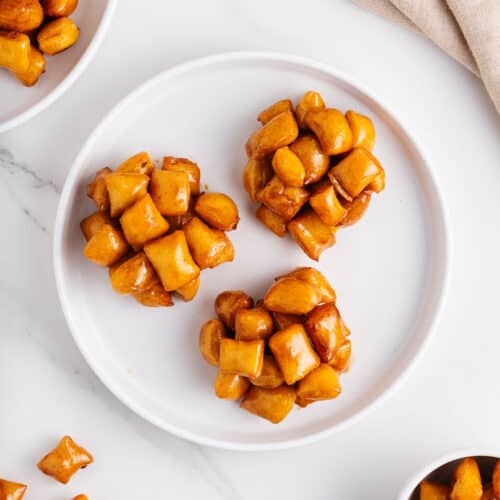Tanghulu Recipe
Try tanghulu for a crunchy, sweet, and juicy snack! This Chinese treat features skewered fruits covered in a hard candy shell. Learn how to make your own version at home with this simple-to-follow recipe!

Made with only 3 ingredients, tanghulu is the perfect way to curb your sweet tooth! It has the perfect balance of juicy fruit and sweet sugar coating. For more fruity dessert ideas, check out my vegan peach cobbler.
Why I love this recipe
Tanghulu (or bing tanghulu) is traditionally made with Chinese hawthorn, but I like to use easily accessible fruits like grapes, apples, mandarin slices, or strawberries to keep the recipe as straightforward as possible.
Once you learn my tips and tricks for dealing with the sugar coating, tanghulu is surprisingly easy to make. Plus, it only takes about 20 minutes from start to finish.
All that’s required is heating sugar and water, then dipping different fruits in. Watch as each one transforms into a beautifully glossy and crunchy candy before your very eyes! Almost anyone can enjoy this vegan, gluten-free, and oil-free confection.
Ingredient notes
Once you pick your favorite fruits, you’re essentially ready to go! Find a full ingredient breakdown and suitable substitutes below.

Fruits
While Chinese hawthorn is the most traditional, this fruit isn’t very easy to find! Instead, look for firm fruits like strawberries, grapes, and blueberries since they can withstand the hot sugar coating. Other options include mandarins, kiwis, or apples. Just make sure you pat the fruit dry so the syrup sticks.
Cane sugar
Cane sugar dissolves into a clear syrup that crystallizes to form the hard candy shell around the fruit. I use organic cane sugar or vegan-friendly granulated sugar.
Substitute: For a rich, toffee-like flavor, swap in organic brown sugar instead of cane sugar or regular granulated sugar.
For a complete ingredient list and step-by-step guide, scroll down to our recipe card.
How to make
Learn the best way to make tanghulu with my straightforward, easy-to-follow instructions. Look for the tips in green throughout this section for consistent and successful results!
Preparation
Step 1
Thoroughly wash or peel the fruit, then pat it completely dry. The sugar syrup will not stick to wet fruit. If you’re using larger fruits like oranges or kiwis, cut them into bite-sized pieces.
Step 2
Line a baking sheet with parchment paper and lightly grease it to prevent sticking, or grab out a styrofoam block, which will prevent flat spots. You will also need some wooden skewers and a candy thermometer ready.
Assembly
Step 1
Using bamboo skewers, pierce each fruit until it’s secured in place. Add just enough fruit to each skewer so that it will be able to fully submerge in the sugar mixture.

Step 2
Combine 1 cup of cane sugar and ½ cup water in a medium saucepan. Clip your candy thermometer to the side and heat the mixture over medium. Let it boil for about 15 minutes without stirring until it reaches 300 degrees Fahrenheit (hard-crack stage).
Resist the urge to stir the syrup as it cooks — stirring can cause the sugar to crystallize. Also, don’t let the thermometer touch the bottom of the pan to keep the reading accurate.


Step 3
Fill a medium mixing bowl with ice water and set it aside. Once the syrup reaches 300 degrees Fahrenheit, remove it from the heat. Dip each fruit skewer into the syrup, ensuring it’s fully coated.
Work quickly but carefully, as the syrup will start to harden as it cools.

Step 4
Immediately after coating the fruit, submerge it in the ice bath. Remove it quickly from the water and place the skewers on the prepared baking sheet or pierce it upright into the foam block.

Step 5
Repeat until there are no skewers and fruits left. Let the tanghulu cool for a few minutes, then serve immediately. Happy eating!
Expert tip
Working with sugar, especially reaching the hard-crack stage, requires precise temperature control. For this reason, I don’t recommend making tanghulu without an accurate candy thermometer, especially if it’s your first time.
The sugar syrup MUST reach 300 degrees Fahrenheit in order to harden into a clear, glass-like coating around the fruit without becoming brittle or tacky. Trust me, it is not fun eating or cleaning up sticky, semi-hardened sugar syrup!
Another step that can’t be missed is patting the fruits dry and ensuring they’re at room temperature before dipping. This prevents the syrup from seizing and helps it cling smoothly to the fruit.
Recipe tips
Keep everything ready: Have your parchment paper, ice water bath, and skewered fruits prepared before you start cooking the sugar syrup. Once the sugar starts heating, you need to be ready.
Safety first: Boiling sugar is extremely hot and can cause severe burns. Use long skewers and keep your work area clear of children and pets.
Test the sugar: Whether you have a thermometer or not, test a drizzle of the sugar mixture in the ice water. If it hardens quickly, you’re ready to dip the fruit. If it’s still sticky and bendable, the syrup needs to simmer for a bit longer.
Clean your pot: The best way to clean out hardened sugar from a saucepan is to add more water and bring it to a boil. Once it’s boiled, dump it out in your sink and repeat until it’s fully clean.
Add an acid: If you’re having issues, squeeze lemon or lime into the sugar mixture before simmering it to avoid crystallization.

Frequently asked questions
While I recommend using a thermometer, you can make this tanghulu recipe without one. Test the sugar mixture by drizzling a small amount into the bowl of cold water. If it immediately hardens, it’s ready to dip fruit in.
The fruit was either not patted dry, or the sugar mixture wasn’t hot enough. If you followed both steps accurately, you may live in a humid climate, which can also affect the hardening process. Place the skewers in your fridge to set.
The best ratio of sugar to water is 2:1. Depending on how much fruit you have, you can adjust the measurements of this recipe up or down.
Storing
It’s best to eat tanghulu immediately for a perfectly crunchy texture. However, if you have leftovers, keep them in an airtight container for up to 3 hours in the fridge.
You can store them for up to a few weeks, but the sugar syrup will start becoming sticky and lose its crunch. Freezing will result in crystallization, so I don’t recommend this storage method.
More candy recipes
Hungry for more?
If you enjoyed this recipe, please consider leaving a star rating and a comment down below! Your feedback not only helps others discover our blog but also gives us valuable insights from your experience.
Don’t forget to subscribe to our newsletter for the latest recipes, and check out our shop for our top kitchen recommendations. Thank you for supporting BBV!
Recipe

Easy Tanghulu Recipe (3 Ingredients)
Equipment
- Small saucepan
- Wooden skewers
Ingredients
- 1 pound fruit of choice (strawberries, grapes, blueberries, oranges, kiwis, etc.)
- 1 cup cane sugar
- ½ cup water
Instructions
- Wash or peel the fruits and slice them if necessary. Thoroughly pat the fruits dry to help the sugar coating stick. Lightly spray a piece of parchment paper with cooking spray or grab a styrofoam block if you have one. Set aside.
- Pierce each fruit with a wooden/bamboo skewer until it’s secured in place. Add just enough fruit to each skewer so that it will be able to fully submerge in the sugar mixture.
- Place a candy thermometer in a medium saucepan, then add the sugar and water. Heat the mixture over medium until it reaches 300°F. Do not stir it and be careful not to exceed 300°F or the sugar will burn.
- In the meantime, fill a medium mixing bowl with ice water.
- When the mixture reaches 300°F, dip a fruit skewer, swirling to coat it evenly. Immediately submerge it in the ice bath. Remove it quickly from the water and place it on the piece of parchment paper or pierce it upright in the foam block to dry.
- Repeat until no skewers are left. Let the tanghulu cool for 2-3 minutes, then serve immediately. Happy eating!
Notes
Nutrition
Note: I’ve updated this post to include new information and helpful tips about the recipe.
Justine Drosdovech is a food writer, photographer, and one of the founders of Broke Bank Vegan. She is a self-taught plant-based chef but uses her healthcare background to craft dishes that are both delicious and nourishing.




